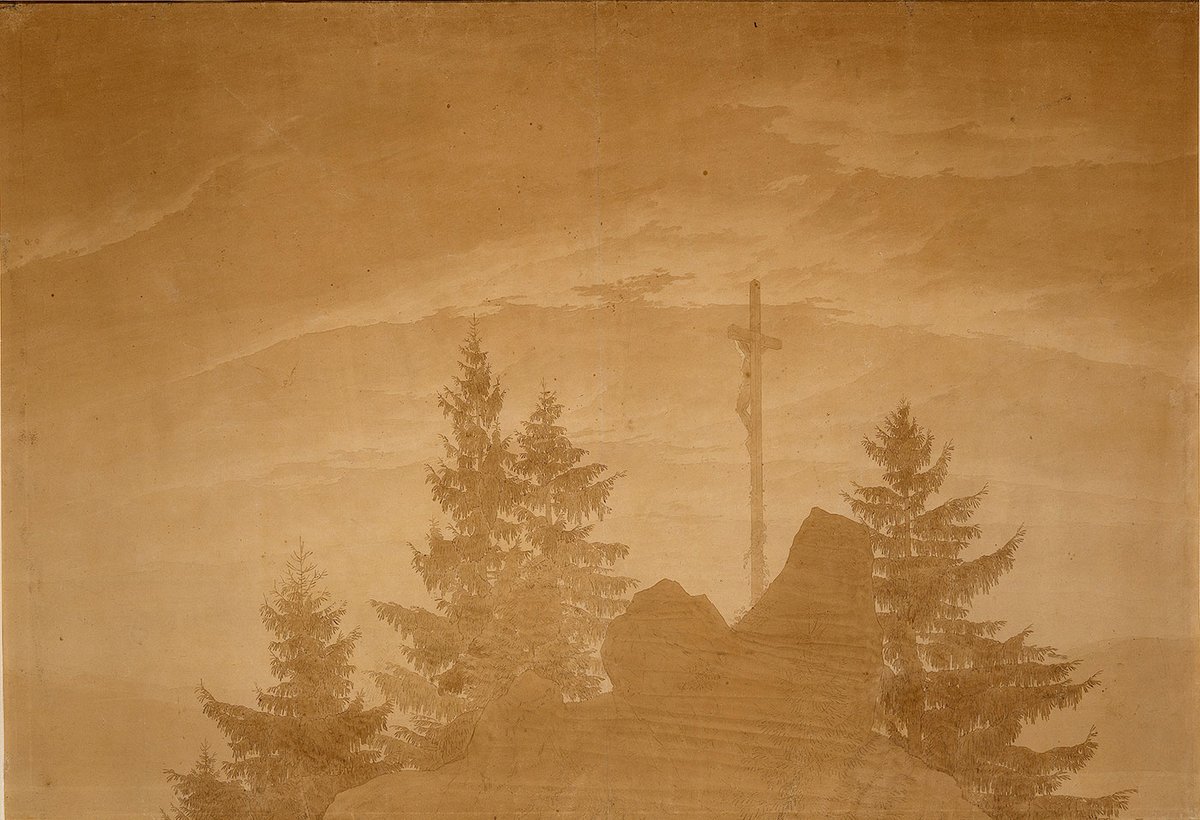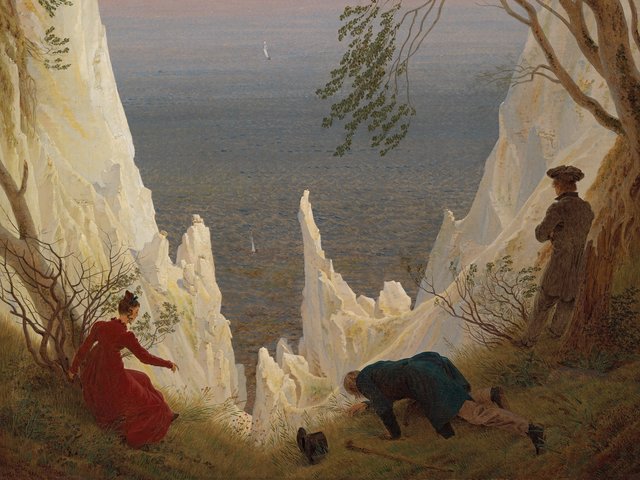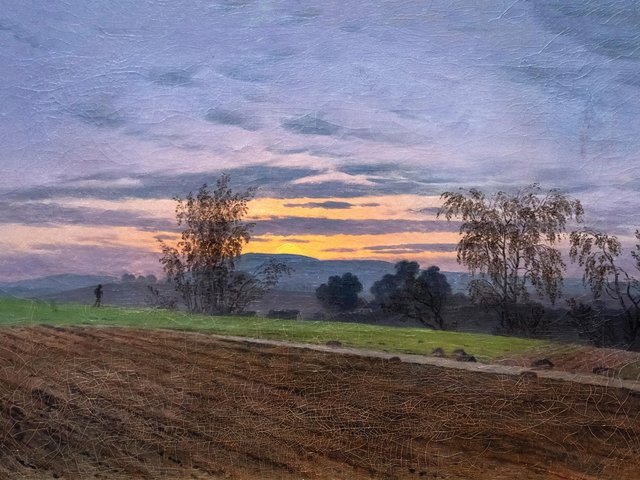Since the pioneering exhibition at the Hamburger Kunsthalle in 1974, interest in Caspar David Friedrich(1774-1840) has never waned. The number of articles, books and exhibitions has vastly increased. An exhibition with even the remotest connection to any subject that Friedrich chose to depict never fails to include one of his paintings. He has become the standard-bearer for “German art of the Romantic period”. (But it is curious that Friedrich should not be the focal point of the exhibition of German Romantic prints and drawings from the collection of the publisher, Charles Booth-Clibborn, currently at the British Museum, until 9 April 2012. Here, on the contrary, he trails behind far lesser-known contemporaries.)
The first reliable catalogue raisonné of Caspar David Friedrich's drawings
Something stranger still to Friedrich scholars is the fact that there has until now, amazingly, never been a reliable catalogue raisonné of his drawings. A work showing the close connection between his drawings—whether sketches from nature or preliminary ideas for a painting—and his completed paintings, would have helped us better to understand the entire body of his graphic works. Until now, researchers have had to make do with Das gesamte graphische Werk (the complete graphic works) by Marianne Bernhard, published in 1974 by the ambitious and long since defunct Verlag Rogner & Bernhard just at a time when interest in Romanticism was increasing in leaps and bounds. Before that, the only work available to experts was Caspar David Friedrich als Zeichner (Caspar David Friedrich, draughtsman), a 1966 study by the East German art historian Sigrid Hinz that was never published in book form and was confined to specialist libraries. A third catalogue raisonné worthy of mention is Caspar David Friedrich. Gemälde, Druckgraphik und bildmässige Zeichnungen ("Caspar David Friedrich. Paintings, prints and drawings") by Helmut Börsch-Supan, a leading expert on Friedrich’s work—as he is on every aspect of Romantic art and culture. Published in 1973, the book was based on the earlier work of Karl Wilhelm Jähnig. However, as the title suggests, Börsch-Supan did not specifically intend it to be a catalogue of Friedrich’s drawings.
Although it does not explicitly claim to be a complete record of the artist’s oeuvre, Christina Grummt’s book promises to be the definitive catalogue that, apart from the occasional addition or possible correction, will have no need of a successor. Grummt, whose previous essays on the subject have proved her to be an expert in her field, calls her massive, two-volume work simply Caspar David Friedrich: die Zeichnungen (Caspar David Friedrich: the drawings). It contains 1,006 autographed works—at least 100 more than Marianne Bernhard. The total is even higher if we take account of the not inconsiderable number of de-attributions—Grummt calls them “questionably attributed works”—listed in the appendix.
How Friedrich produced his Karlsruhe sketches in a short burst
Because Friedrich’s work is so well known and his drawings so highly sought after at auction, the newly catalogued works come only from unnamed private collections, such as the series of 29 drawings which Grummt discovered in a lost sketchbook, or to be more precise, a sketchbook dating from 1804 that had been broken up into single pages, the vast majority of which are in a private collection in Karlsruhe. It is especially exciting to be able to peer over Friedrich’s shoulder and see how he produced the Karlsruhe sketches in such a short burst—from 13 April to 1 June 1804. Friedrich was then living in Dresden and made his sketches there or somewhere in the vicinity. The penetrating and minutely detailed analysis that Grummt undertakes for every print in her catalogue links each individual branch or twig to Friedrich’s later works in oil, and even those combinations of tree parts are related to their later painted counterparts.
Why Friedrich was one of the most significant draughtsmen of his time
So what is there to gain from reconstructing the creative process behind individual paintings? First, an appreciation of the artist as one of the most significant draughtsmen of his time. Second, the realisation that Friedrich’s paintings—of which there are many, sometimes controversial, interpretations—are firmly based on the observation and appropriation of the natural world. Maybe Friedrich composed his paintings, literally put them together, from elements that were “real”, inasmuch as they existed in nature where the artist found them and recorded them in their original state. We can take as an example his pencil and watercolour Kreidefelsen auf Rügen ("Chalk cliffs on Rügen island"), 1825, now in the Museum der bildenden Künste, Leipzig, the subject of which reappears almost unchanged in the famous painting of the same name in the Stiftung Reinhart, Winterthur, Switzerland. However, Friedrich added figures, seen against the landscape, acting out an allegory of the different stages of human life. Friedrich charges the natural world with meaning without falsifying nature itself. He also sets the line of the horizon so high that the eye of the spectator is drawn straight into the ravine.
According to contemporary evidence, the drawing, which appears in the book in its original size and of course in colour, was one of a series of no fewer than “37 views of the coves and cliffs of Rügen Island”. The outstanding quality of these works makes it especially sad to realise that only four verifiable drawings from the series have survived. The remaining three are surprisingly different from Chalk Cliffs, consisting as they do of a vast, empty sky above a flat, unspectacular landscape, an example of the emptiness that is one of the main stylistic features of Friedrich’s draughtsmanship. He uses empty space to highlight the subtle and painstakingly detailed way in which he depicts his subject matter.
Friedrich is also known to have produced architectural drawings but these were rare or, like those in the Germanisches Nationalmuseum, Nuremberg, have never been put on show. The Nuremberg museum has in its possession 26 pages dating from 1817/18 with Friedrich’s neo-Gothic designs for the interior of the Church of St Mary in Stralsund, ranging from the chancel to the chalice. Nevertheless, one drawing in the series, the design for the altar, is well known. It shows the Tetschen Altarpiece, 1807-08, also known as The Cross in the Mountains. The religious role in which Friedrich cast the natural world is clearly shown in this drawing. In 1825, Friedrich produced designs for a monument to commemorate the war of liberation against Napoleon’s occupying forces in the form of a decorative column.
Christina Grummt is not concerned with interpreting the drawings and the drudgery that this involves, not to mention the endless journeys to see works in the original. There are still many questions to be asked about the drawings she has left out, all the more so since her justification is always the same for each “downgrade”: The “artistic observation and graphic interpretation of the subject matter cast doubt on Friedrich’s authorship”.
A negative judgement on Friedrich's early sepia drawings
Most controversial is her negative judgement of the early sepia drawing, executed some time around 1793 and recognised by all scholars, Idealised Mountain Landscape with Waterfalls. Werner Hofmann, who, when he was director of the Hamburger Kunsthalle began his major exhibition cycle, “Kunst um 1800” (“Art around 1800”) with the 1974 exhibition referred to above, accorded this very work pride of place and highlighted it in his insightful study of the artist published in 2000. He claims it is an early example of Friedrich’s “revolutionary imagery”, which was echoed in the work of others, such as Joseph Anton Koch. Hofmann quotes Friedrich’s own stated intention: what he aimed at was “to depict nature in its simplicity, nobility and vastness, just as it is, if one has the mind and the sensitivity to perceive it”.
The Idealised Landscape may not quite measure up to Friedrich’s self-imposed standards, but in this work we can recognise the formal means by which the artist was able to infuse the landscape with “spiritual and religious significance” and how he succeeded in, as Hofmann puts it, “transposing the near distance into the far distance and suddenly allowing the accessible to be permeated with the inaccessible lying hidden behind it”. Whether the drawing was in, fact, the prima idea remains debatable, but it would have been enlightening to read Grummt’s assessment of the work.
Friedrich experts may well wish to continue the discussion, but the fact that they can do so is thanks to this impressive work. Likewise, it is to the credit of the publishers, Verlag C.H. Beck, that they continue to publish books on the history of art in the full knowledge that only very rarely will they be a commercial success. In the case of the Friedrich catalogue, the generous support of the Alfried Krupp von Bohlen und Halbach Foundation has made possible these two beautifully produced volumes with their 1,284 duotone or colour illustrations. Nothing could take us closer to Caspar David Friedrich’s draughtsmanship than these do.
- Christina Grummt, Caspar David Friedrich: die Zeichnungen—das Gesamte Werk ( Verlag C.H. Beck, 2011), 2 vols, 1,284 colour and duotone illustrations, €198





